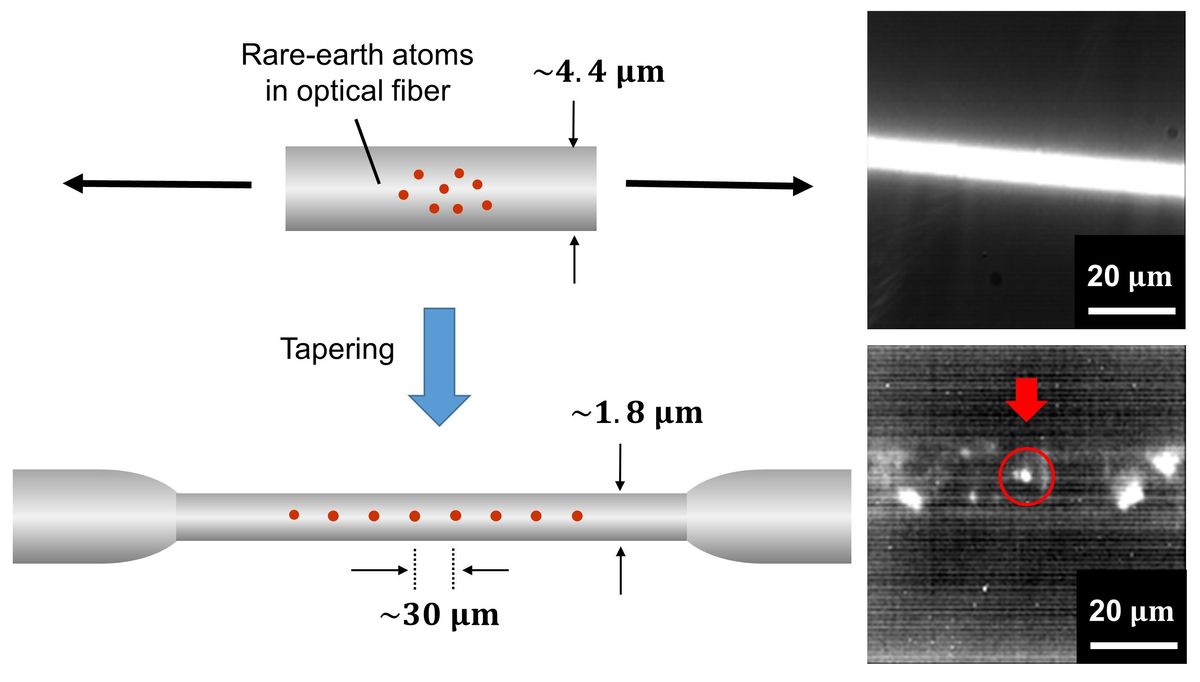Producing photons one at a time on demand at room temperature is a key requirement for the rollout of a quantum internet—and the practical quantum computers that would undergird that network. The photons can be used as quantum bits (qubits), the quantum equivalent of classical computing’s 0s and 1s. Labs around the world have devised various ways to generate single photons, but they can involve complex engineering techniques such as doped carbon nanotubes or costly cryogenically cooled conditions. On the other hand, less complicated techniques such as using traditional light sources do not provide the necessary level of control over single-photon emissions required for quantum networks and computers.
Now, researchers from Tokyo University of Science (TUS) and the Okinawa Institute of Science and Technology have collaborated to develop a prototype room-temperature single-photon light source using standard materials and methods. The team described the fabrication of the prototype and its results in a recent issue of the journal Physical Review Applied.
“Our single-photon light source...increases the potential to create quantum networks—a quantum internet—that are cost-effective and accessible.”
—Kaoru Sanaka, Tokyo University of Science
The emitter comprises commercially available amorphous silica optical fiber, predoped with optically active rare earth (RE) ytterbium ions. In other words, the cable is relatively run-of-the-mill for a doped fiber-optic line. The difference comes during fabrication, when the researchers used a conventional process called heat and pull—involving, as the name implies, heating and stretching the line like taffy. However after heating, they used a programmable stepping motor to pull the fiber, gradually reducing its core diameter, and creating a controlled taper.
“Our single-photon light source is low cost, not so technically complex, and it can be fabricated at room temperatures,” says Kaoru Sanaka, an associate professor at TUS, who led the team of researchers. “This eliminates the need for expensive cooling systems and increases the potential to create quantum networks—a quantum internet—that are cost-effective and accessible.”
Sanaka says that in conventional approaches, such as fabricating a quantum-dot single-photon emitter, the quantum particles are embedded into the outside of a tapered fiber. But doing so also hinders the efficient capture and guidance of emitted photons via the fiber’s internal optic mode, also known as channeling efficiency—the mechanism by which the photons are coupled into and channeled through the fiber based on the fiber’s structure. In contrast, RE ions are embedded and aligned inside the fiber’s core during its manufacture, which optimizes the structural capture and channeling of the photons.
“The channeling efficiency of the photons emitted from the optical-fiber core into the fiber-guided mode is simply determined by the refractive index of the fiber,” says Sanaka, referring to the measurement of how much the light slows down as it passes through the material. “Whereas the channeling efficiency of the photons emitted from externally embedded emitters is limited by the fiber-core size and the wavelength of the emitted photons.”
The heat-and-pull tapering procedure stretches the spacing between the individual ytterbium ions and effectively turns them into single-photon emitters.
The average distance between the separated ions “needs to be more than the optical diffraction limit, which is determined by the wavelength of the emitted photons—about one micron,” says Sanaka. “The average distance of about 30 microns between distributed single RE atoms [shown in the illustration above] is much larger than the optical diffraction limit. So it’s possible to extract the photons emitted from each spatially isolated RE ion.”
To confirm the nature of the photons, the researchers used a measurement technique called autocorrelation. Autocorrelation measurement is a mathematical and statistical technique used to evaluate the similarity between a signal and its delayed version. This helps the researchers understand temporal patterns in the emitted photons and to ascertain that the emitted light comes from individual sources.
In order to induce emissions, a continuous-wave pulsed laser is coupled to the fiber directly. At present, the emission timing of an emitter is restricted by the radiation time determined by spontaneous emission of the ion—about 1 millisecond.
Igor Aharonovich at the University of Technology Sydney, who is chief investigator at Australia’s ARC Center of Excellence for Transformative Meta-Optical Systems, says the Japanese team’s approach has been tried before, but previous efforts haven’t been able to scale. “While integrating a known system like a rare-earth element into fiber is an interesting approach,” he says, “It does not inherently create a better single-photon emitter. One could consider finding the brightest available emitter first and then integrate it reliably into the fiber.”
In response, Sanaka says testing other RE elements is on the agenda, the next being erbium-doped fiber, which is also available commercially. The researchers are also working to increase the quantity of emitted photons and to improve their quality and speed of emission. To do this, they must develop micro- or nanoscale cavities. Cavities are tiny spaces fabricated near or on the surface of the emitters that act as resonators for the photons, resulting in a more controlled and concentrated release of light. Such cavities will also be used to enhance the indistinguishability of emitted photons—their degree of similarity in such properties as polarization and frequency. This would mark a crucial step in enabling the creation of entangled photon pairs needed to realize such quantum applications as quantum communications and quantum computations.
“By successfully combining cavities with our emitters,” says Sanaka, “we may then be in a position to consider commercialization of the technology.”



